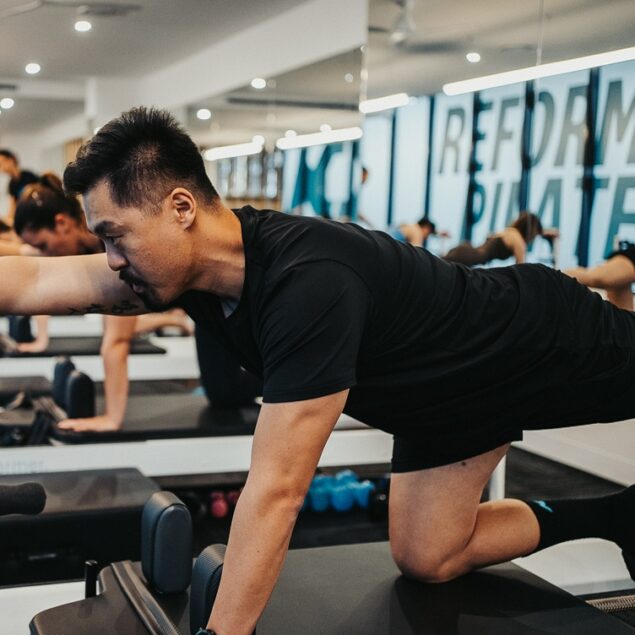
In Pilates, breathing isn’t an afterthought — it’s a vital part of every technique. Whether you’re a beginner or a seasoned practitioner, prioritising correct breathwork can help unlock the full potential of your practice.
In this guide, we explore the key benefits of proper breathing in Pilates, and we also share mindful breathing techniques to help you elevate every session.
With the average human taking around 22,000 breaths each day, the quality of our breathing directly impacts our physical performance and overall well-being.
Breathing is one of the core principles of Pilates. When you breathe deeply and intentionally, you help activate the core muscles, stabilise the spine and maintain alignment throughout each movement.
By establishing proper form, you create the conditions to fully engage the right muscle groups and perform exercises with precision. This allows you to maximise the physical and mental benefits of every Pilates session.
Additionally, slow deep breathing helps calm the nervous system by easing stress and anxiety and sharpening focus to improve performance. In contrast, incorrect breathing techniques can hinder muscle engagement, limit your range of motion and add unnecessary strain to the body.
Any form of exercise increases your body’s need for oxygen as it works harder to sustain physical activity. Effective breathing provides a steady supply of oxygen to your muscles and vital organs. It also helps prevent your body from needing to overcompensate later to restore balance and regulate its systems.
Applying Pilates breathing techniques should leave you feeling calm and centred even after a challenging workout. When done correctly, Pilates breathing helps your body smoothly adjust to shifts in intensity and helps clear your mind of any lingering physical fatigue.
At the heart of Pilates is the mind-body connection, which reflects the intricate relationship between your mental state, emotions and physical actions. Through mindful practice, you develop a heightened sense of body awareness, empowering you to make deliberate choices with your posture and movement.
A key element of mindfulness in Pilates is the emphasis on breathing. Through intentional breathing, you can deepen your connection with your body, quiet your mind and enhance the impact of every exercise.
Below are some mindful breathing techniques to elevate your Pilates practice:
1. Diaphragmatic breathing
The diaphragm is a large, dome-shaped muscle found at the base of your lungs. When used effectively, it allows for deeper, more efficient respiration. Diaphragmatic breathing focuses on activating this muscle to improve oxygen flow and promote relaxation.
This type of breathing provides several benefits:
Steps to practice diaphragmatic breathing:
2. Lateral ribcage breathing
This is a popular breathing exercise for core strength that involves expanding the sides and back of the ribcage during inhalation. It enables deeper breathing and enhances oxygen circulation throughout your body.
Unlike traditional relaxed breathing, where the belly rises and falls, this technique keeps the abdominal muscles gently engaged while expanding your ribs outward. Engaging your abs lets you support your spine and maintain better control over your movements.
To practice lateral ribcage breathwork:
3. Coordinated breathing
Coordinated breathing in Pilates refers to synchronising your breath with your movements. For example, in Pilates, you typically inhale during the preparatory phase of a movement to prepare your body and exhale during the exertion phase to activate your core and support the motion. This deliberate harmony of breath and movement helps you maintain a steady rhythm, improve focus and ensure that the correct muscles are engaged.
Harnessing the power of breathing can help you achieve the right mindset for any activity. By refining your breathing patterns, you can enhance both efficiency and mental resilience, setting the stage for a more effective and intentional workout.
Here are some tips for choosing the appropriate breathing technique:
1. Understand your goals
Whether you’re aiming to enhance flexibility or work on your balance, the optimal breathing technique will depend on the activity and your desired results.
2. Listen to your body
Choose a technique that feels natural and supports your movement without causing tension or discomfort. Adjust your breathing as needed — if you’re struggling to maintain rhythm or focus, shift to a simpler technique to regain control.
3. Seek guidance
Partnering with a skilled Pilates trainer can help you identify the breathing techniques best suited for your needs and ensure proper execution.
By mastering Pilates breathing techniques, you can move with greater intention, control and ease — transforming every session into a truly rewarding experience.
At KX Pilates, our 50-minute beginner, intermediate and advanced classes combine traditional Reformer Pilates principles with innovative methods to deliver full-body workouts for all fitness levels.
Whether you’re just starting your Pilates journey or considering becoming a trainer, our programs are designed to challenge and inspire you. Contact us today to book a class and discover how Pilates can transform your life.